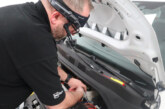
Vehicle emissions are coming under increased scrutiny as UK cities struggle to improve air quality. Are your maintenance regimes keeping pace?
There has been much publicity in recent months about the impact vehicle emissions have on air quality, particularly in urban areas. Some UK cities are proposing to ban non-compliant vehicles from their roads or levy punitive access charges – in practice, this applies to any truck or bus that exceeds Euro VI emission limits.
As a result, enforcement authorities can be expected to be especially alert to any signs of emissions non-compliance both at annual test and during roadside checks.
It makes sense, therefore, to check that your maintenance regime includes all the necessary checks on emissions and emissions control systems (ECS).
Annual Test checks
Additional checks on emissions were introduced for HGVs and PSVs in 2018. Since then, failures due to emissions have risen and are now one of the top 10 defects, accounting for around 1% of test failures annually.
So, what’s changed? Examiners now use manufacturers’ plated limits for smoke testing and Euro VI vehicles have a stricter permitted limit. Three additional checks are now carried out:
- The level of tail-pipe smoke coming from a vehicle equipped with a Diesel Particular Filter
- Is legally mandated emissions control equipment missing, modified, or showing signs of tampering?
- Is the in-cab dashboard engine Malfunction Indicator Light (MIL) on?
Top tips
The latest DVSA ‘Guide to Maintaining Roadworthiness’ includes a new section on exhaust emissions and the importance of correctly maintaining the vehicle’s emissions control system.
It recommends that vehicles showing signs of visible exhaust smoke be checked with a diesel smoke meter to ensure that the level of smoke emission is within the legal requirements. (Information on the levels of permitted exhaust smoke is contained in annual test inspection manuals.) It’s worth remembering, too, that any vehicle presented for test with visible smoke coming from the exhaust will instantly fail.
Vehicles fitted with emission control systems (ECS) need to be maintained in line with manufacturers’ recommendations.
Drivers and operators should monitor the dashboard ECS warning lamps and ensure levels of AdBlue are maintained at correct levels.
Any ECS faults should be rectified as soon as possible and repaired in line with manufacturer’s standards.
The law
Under the Road Vehicles (Construction and Use) Regulations (Regulations 61(7) and 61A(3)) and the Road Traffic Act 1988 (Section 42), it is an offence to use on a road a vehicle which has been modified in such a way that it no longer complies with the air pollutant emissions standards it was designed to meet. The potential penalties are £2,500 for a van, lorry or bus.
Under the Road Traffic Act 1988 (Section 75), it is an offence to alter a vehicle in such a way that the use of the vehicle on a road would be unlawful. A person altering the vehicle (if they knew or believed that the vehicle would be used on the road) could be found guilty of an offence under the Act. Potential penalties are unlimited fines.
Any person using (or causing or permitting to be used) a vehicle on the public road which does not comply with the emissions standards it was designed to meet, is committing an offence. It is the driver who is responsible for ensuring compliance.
Removing a catalytic converter or diesel particulate filter, for example, will almost certainly result in a vehicle’s emissions exceeding type approval limits and make the vehicle illegal to drive on the road. Engine re-mapping may also result in non-compliant emissions.








